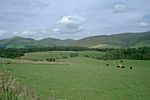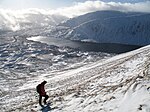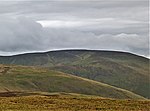Loch Skeen
Dumfries and Galloway geography stubsFreshwater lochs of ScotlandLochs of Dumfries and Galloway

Loch Skeen or Loch Skene is a loch in Dumfries and Galloway in the south of Scotland. It is located about 10 miles to the north-east of Moffat and feeds the 60-metre (200 ft) high Grey Mare's Tail waterfall. The area around Loch Skeen is popular with hikers, and the Daily Telegraph included Loch Skeen in a list of Britain's finest one-day and half-day walks. It is the highest loch in the Southern Uplands at approximately 510m.
Excerpt from the Wikipedia article Loch Skeen (License: CC BY-SA 3.0, Authors, Images).Loch Skeen
Geographical coordinates (GPS) Address Nearby Places Show on map
Geographical coordinates (GPS)
| Latitude | Longitude |
|---|---|
| N 55.433333333333 ° | E -3.3166666666667 ° |
Address
Coomb Craig
DG10 9LH
Scotland, United Kingdom
Open on Google Maps











